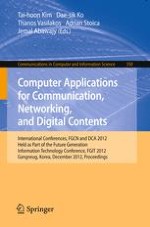2012 | Buch
Computer Applications for Communication, Networking, and Digital Contents
International Conferences, FGCN and DCA 2012, Held as Part of the Future Generation Information Technology Conference, FGIT 2012, Gangneug, Korea, December 16-19, 2012. Proceedings
herausgegeben von: Tai-hoon Kim, Dae-sik Ko, Thanos Vasilakos, Adrian Stoica, Jemal Abawajy
Verlag: Springer Berlin Heidelberg
Buchreihe : Communications in Computer and Information Science
